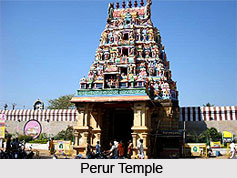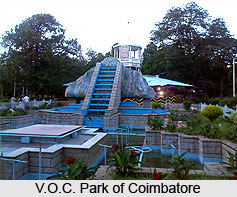 Coimbatore is the third largest city of Tamil Nadu. It is the district headquarters and the most industrialised and commercialised city in Tamil Nadu. Coimbatore is situated 497 kms from Chennai. There are many interesting places in Coimbatore, which are worth visiting. These places can be reached by buses. Some of the places are given here:
Coimbatore is the third largest city of Tamil Nadu. It is the district headquarters and the most industrialised and commercialised city in Tamil Nadu. Coimbatore is situated 497 kms from Chennai. There are many interesting places in Coimbatore, which are worth visiting. These places can be reached by buses. Some of the places are given here:
Perur
It is situated about 7 kms from Coimbatore junction. It is a must visit place due to its sculptural splendour. This place is often called the Mecca of Art Lovers. This place is also known as the Mel-Chidambaram. The temple here was built by Karikal Cholan of 2nd century A.D. The presiding deity of this temple is Patteeswarar with his spouse Pachainayaki. Their shrines can be seen here. The Kanaga Sabha pillars are chiselled with beautiful images. The images of Gajasamhara, Veerabadra, Bikshadana, Oorthuva Thandava and Veena Pani Saraswathi are carved very nicely. The corridors of the temple are very impressive and have several carvings on them. Every year, thousands of visitors come here to attend the Panguni Uthiram festival in March-April.
The Noyyal River flows here with green lushy banks. The Santhalinga Adigalar Mutt and Tamil College here are other worth visiting places.
Agricultural University of Coimbatore
The Agricultural University of Coimbatore is the most famous and the best in South East Asia. Originally, it was founded as an agricultural farm in Saidapet, Chennai and later moved to Coimbatore in 1907. Earlier, it was known as Agricultural College and it developed into the Agricultural University later. It is 5 kms from railway station.
 G.D.Naidu Industrial Exhibition of Coimbatore
G.D.Naidu Industrial Exhibition of Coimbatore
This is technical institute, established by G.D. Naidu the famous technocrat of yester years. He was a legend in his own time. His contribution to automobile, electronics, mechanical and agricultural sectors are priceless. He founded this Industrial Exhibition here, which is a splendid exposure to science, technology and modern industry.
V.O.C. Park of Coimbatore
This massive park was named after the eminent freedom fighter and patriot V.O.Chidambaram Pillai. Now, the Municipal Corporation maintains this park. A mini zoo and a joy train in this park are used by the children as well as the grown-ups of Coimbatore.
Forest College of Coimbatore
This is situated only 3.5 kms from the railway station of Coimbatore. It is one of the oldest institutes of its kind in India. Forest rangers are trained here. The college museum has wonderful collections.
Mundhi Vinayagar Temple of Coimbatore
This temple of Coimbatorte is situated in the heart of the city. The huge statue of Vinayagar here is a modern attraction and landmark of the city.
Ichanari Vinayagar Temple of Coimbatore
This is a modern Vinayagar temple, situated on the outskirts. It has become very popular nowadays. The temple is kept perfectly clean with many modern facilities.



















